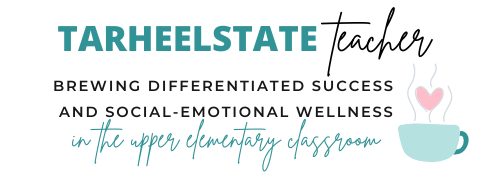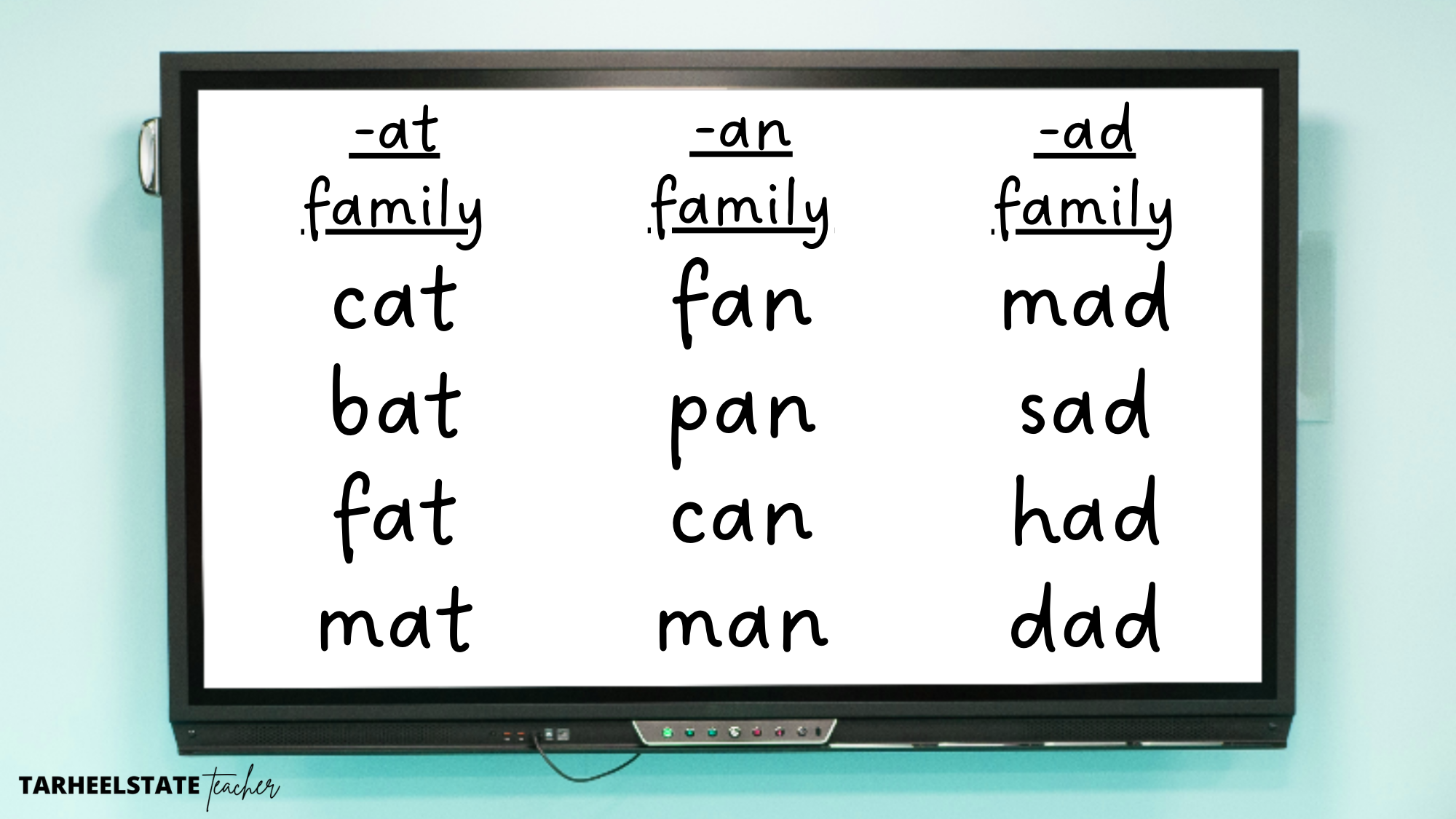Teaching Phonics Word Families - Letter Name-Alphabetic Spellers
Will you be teaching phonics word families soon? Let this blog post be your handy go-to as you brush up on what word families are, common word families to teach, and why word families are beneficial for students learning to read and spell. Then we'll move on to how you'll know when students are developmentally ready to start working with word families and a suggested pacing and order for when those common word families should be taught. And, of course, we'll discuss ideas for making the teaching of word families more fun and effective!
WHAT ARE PHONICS WORD FAMILIES?
Word families, also known as phonograms, are groups of words that follow the same spelling pattern. For example, can, van, fan, pan, man, ban, and tan are all spelled with a beginning consonant and -an. We can group these words into “families” to help students better hear and visualize the pattern, setting them up to be successful with new words they encounter with the same pattern.
According to Wylie and Durrel, there are 37 common word families, including ack, ain, ake, ale, all, ame, an, ank, ap, ash, at, ate, aw, ay, eat, ell, est, ice, ick, ide, ight, ill, in, ine, ing, ink, ip, it, ock, oke, op, ore, ot, uck, ug, ump, and unk.
WHY DO WE TEACH PHONICS WORD FAMILIES?
Because it is more challenging for students to isolate individual phonemes in CVC words (b-a-g or c-a-p), word families provide an easier and more natural pathway for students to practice phonological blending as they begin to learn about short vowels (i.e. b-ag or c-ap).
Teaching word families also helps to significantly and quickly expand students’ vocabulary in both word recognition and spelling. If students are simply trying to memorize a list of CVC words that are unrelated, they are limited to learning only those handful of words. When students are introduced to the patterns and rime aspect of word families, they suddenly have access to all the words that fit into each particular word family.
For example, if a student is learning about the ap word family and learns the word cap, they will quickly be able to read and spell lap, map, nap, gap, rap, sap, and tap by blending the onset, or beginning sound, with the rime, ap.
WHEN ARE STUDENTS READY TO START WORKING WITH WORD FAMILIES?
As soon as students have mastered identifying beginning consonant sounds in CVC words and are showing some success in using consonants in the final position, introducing word families is the next developmental step in order to move students from isolating individual phonemes to phonological blending. According to Wiley Blevins, a typically developing student should be ready for this in kindergarten.
Need tips for supporting students in all phases of the Letter Name-Alphabetic stage? Get those here!
WHAT ORDER SHOULD WORD FAMILIES BE TAUGHT IN?
It is best for students who are just beginning to explore short vowels and word families to focus on one vowel at a time, using both pictures and written words for support. Providing students with repeated practice with CVC words from the same word family engages them in using initial and final consonants as they begin to make generalizations about the role rhyme plays in word families.
Words Their Way suggests introducing word families with the same vowel in the following order and pairings:
1 - AT Word Family - bat, fat, cat
2 - AN and AD Word Families - fan, mad, pad, sad
3 - AP and AG Word Families - cap, lap, bag, rag
4 - OP, OT, and OG Word Families - hop, mop, dot, hot, dog, jog
5 - ET, EG, and EN Word Families - net, wet, beg, peg, hen, pen
6 - UG, UT, and UN Word Families - bug, jug, cut, hut, bun, run
7 - IP, IG, and ILL Word Families - lip, zip, dig, pig, hill, pill
* Note: I've linked each of these same-vowel word families examples to resources that can be used to teach these skills. You can find the bundle for teaching Short Vowel Word Families here.
Once students successfully start applying their knowledge of same-vowel word families to reading, writing, and speaking, they will benefit from work with mixed-vowel word families in order to continue practicing blending onsets and rimes. Students also begin to focus more on identifying short vowel sounds in order to prepare for working with CVC words without the support of word families.
Words Their Way suggests the following groupings and order for mixed-vowel word families:
1 - AT, OT, and IT Word Families - mat, rat, cot, got, sit, kit
2 - AN, IN, and UN Word Families - can, pan, pin, fun, sun, run
3 - AD, ED, AB, and OB Word Families - sad, had, red, fed, cab, lab, cob, mob
4 - AG, OG, IG, UG, and EG Word Families - tag, rag, dog, fog, pig, dig, hug, rug, leg, beg
5 - ILL, ELL, and ALL Word Families - bill, will, sell, tell, ball, call
6 - ACK, ICK, OCK, and UCK Word Families - sack, tack, kick, sick, sock, lock, duck, luck
7 - ISH, ASH, and USH Word Families - wish, dish, mash, cash, hush, rush
* Note: I've linked each of these mixed-vowel word families examples to resources that can be used to teach these skills. You can find the bundle for teaching Mixed Vowel Word Families here.
WHAT TYPES OF ACTIVITIES BENEFIT STUDENTS WORKING WITH WORD FAMILIES?
At this phonological developmental stage, students need LOTS of practice and exposure to same-vowel and mixed-vowel word families. It is also important to provide a variety of activities that allow students to interact with these words through identifying, matching, comparing, sorting, building, and writing/spelling.
I love using games in my word study routine because it allows me to engage students in many of these skills all at once, while also easily captivating their attention. In the examples below, I've linked the games and activities I've created for teaching and practicing word families.
Connect 5 is a game I love to use when teaching word families. Students take turns drawing cards that contain a mixture of pictures, words, or clues and must cover a picture or word on the game board that corresponds to the card drawn. The first person to connect any five consecutive spaces on the board wins the game. Throughout the game students identify, match, sort, and blend the onset and rimes of the particular word families.
I also love using Spin, Cover, Build, Write activities for many Letter Name-Alphabetic concepts. This activity incorporates pictures and challenges students to apply what they have been learning in order to build and write their word study words. For example, when working with word families ILL, ELL, and ALL, students will spin a word family and search for an image to cover that depicts a word belonging to that particular word family. They must then build and then write the word on their recording sheet, sorting it into the appropriate category.
You can find all the games and activities I suggest using in the Short Vowel Word Families BUNDLE and the Mixed Vowel Word Families BUNDLE.
YOU’VE GOT THIS, TEACHER FRIEND!
Think of these beginning word study concepts as laying the first layer of bricks to a structure. The first layer is arguably the most important. If it’s done too quickly, the quality of the rest of the work doesn’t really matter. It's important that we don’t rush students through these foundational stages of learning about letters, sounds, spelling, and reading. The more varied opportunities students have to practice and apply word families to their reading and writing, the stronger their foundation will be as they move toward working with short vowels and CVC words outside of the support of word families.
Have students in the Letter Name-Alphabetic Stage that are ready to work on other concepts? Check out these helpful posts:
Supporting Students in the Letter Name-Alphabetic Stage
Teaching Beginning Consonants Letters and Sounds
Teaching Beginning Digraphs and Blends in CVC Words
Teaching Short Vowels in CVC Words
Teaching Preconsonantal Nasals in CVC Words
LOOKING FOR MORE LETTER-NAME ALPHABETIC RESOURCES?
You can get all of the Letter Name-Alphabetic Stage games in a time-saving, money saving bundle!
NOTE: The Letter Name word searches and word study notebook are also included in bundles for all 4 levels of Words Their Way if you need those!




